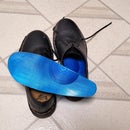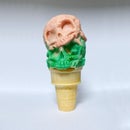Introduction: 3d Print Gemstone Ring
With 3d printing, anyone can make personalized ring jewelry. Usually the printed plastic ring is used to cast molds to create metal versions of the ring and the gemstones, if needed, sourced. But for simple cosplay or for people like me that don't wear jewelry often, this seems like overkill in time and money. It may be the budget saver in me, but I don't want to pay a lot to create something I am not going to wear or use often. But I do want to wear jewelry that looks awesome. So this got me thinking. What if a 3d printed plastic ring with a printed gemstone could be post processed to look close to a metal ring with a gemstone?
Step 1: Project Materials:
- SLA/DLP 3D Printer
- Clear Resin
- Black Acrylic Paint
- Metallic Paint
- Rub 'n Buff paint (same color as metallic paint)
- Soft cloth (optional)
- Small Paint Brushes
- Glitter Nail Polish
- Clear Top Coat Nail Polish
- Colored Sharpie Permanent Marker
Notes:
A FDM/FFF Printer can work with proper post processing work. If using filament I recommend Taulman t-glase. After the print is complete then treat the design with XTC-3D from Smooth-on to improve clarity of the print.
Step 2: Design Brief: Choose a Ring Style
I use ZBrush to create a majority of my 3D printable designs. Zbrush comes with 3 ring variation projects accessible through the lightbox menu. My favorite ring style to work with is the Signet ring.
If you do not have zbrush, any 3d program will do such as Tinkercad to make a ring. If you do not want to design your own ring you can find printable jewelry design on Myminifactory.com or other sites.
Step 3: Design Brief: Create Gem
In zbrush I added a sphere and aligned it to the area where I would like the gem to be. I then proceeded to subtract sculpt the planars of a cut gem look with a clay brush. Once it was to my liking I cut the sphere in half and deleted the unnecessary part of the sphere mesh.
Step 4: Design Brief: Create Border
Using the mask tool, I created a border to my ring and created a polygroup from it. This was to make it easier to hide the border so I couldn't edit the area when detailing the ring band.
Step 5: Design Brief: Create Band Details
Hiding the ring border I then loaded a black and white graphic into the alpha channel of the mask brush and, with symmetry on, proceeded to mask out the ring band details. Once happy with the masking layout, using the scale tool in zbrush I extruded the detail inwards to create some depth to the band.
Step 6: Design Brief: Solidify Mesh
Unhiding the border, I then proceeded with solidify the ring into one solid model using Zbrush's Boolean tool.
Step 7: Design Brief: Export Ring
Loading Zbrush's jewelry mandrel model from the Jewelry _Mandrel project file into my ring project scene I used the imported file as a sizing reference. Using the 3D Print Hub zBrush plugin, I sized the Mandrel according to my ring size (Ring size chart) and then exported the ring.

Step 8: 3D Printing: Printing on a SLA/DLP Printer
In order achieve a somewhat believable gemstone, the design needs to be printed in a clear resin to achieve best results. The idea is to replicate a "glass effect" that can reflect light like a actual gemstone.
I printed my ring on a Sparkmaker DLP printer at a 50 micron resolution with LCD-T resin.
Want to use this design? The file is available for purchase on Myminifactory.com.
Step 9: 3D Printing: Cleaning and Cure SLA/DLP Print.
Once your print is complete follow the clean up procedure for your particular printer. For the Sparkmaker I had to rinse thoroughly the print in 99% Isopropyl Alcohol and finish curing the left over residue in the sun.
Step 10: Post Processing: Add Sparkle Nail Polish
On the inside of the ring under the gem, add a thin layer of sparkle nail polish. Allow to dry. Add additional 1-2 thin coats.
Step 11: Post Processing: Color Gem
With the sharpie, color the gem on the topside of the ring. You don't have to be perfect, just make sure all of the gem is covered with the color.
Step 12: Post Processing: Add Clear Coat to Gem
Add a thin coat of clear top coat of nail polish on top of the sharpied area. The color will run which will help create a "glass effect" and bring forth the sparkle of the underside nail polish through the gem. To make the gem color darker, re-apply the sharpie once the top clear coat is dried. Re-apply clear coat nail polish as needed.
Step 13: Post Processing: Apply Black Paint
With a paint brush, apply black paint to the ring band. This step is mostly prep work to give the metallic paint something to adhere too.
Step 14: Post Processing: Apply Metallic Paint
With a paint brush, apply the metallic paint to the details of the ring band. I usually like to leave the crevices of the ring black.
Step 15: Post Processing: Apply Rub N' Buff
Once metallic paint is dry, with a small brush apply Rub n' Buff over the painted metallic areas. With a finger or soft cloth, gently buff to a beautiful luster. The more buff, the more shine.
Optional: apply a clear gloss spray on the ring to seal it to prevent wear.
Step 16: Final Result
Though it doesn't look like a metal ring up close due to the print lines, the affect is fairly realistic at a short distance and the gemstone looks believable. The overall post-processing technique has created a piece of jewelry that I am happy to wear without breaking my budget.






